Special purpose audio gadget: Stirlitz voice recorder, its real prototype and bold historical modeling
Any series of articles dedicated to audio gadgets of the special services and written in Russia would be incomplete without a story about the so-called. voice recorder Stirlitz. This device was familiar to almost all citizens of the USSR from 1973 on shots from “Seventeen Moments of Spring” and was strongly associated with a spy gadget.
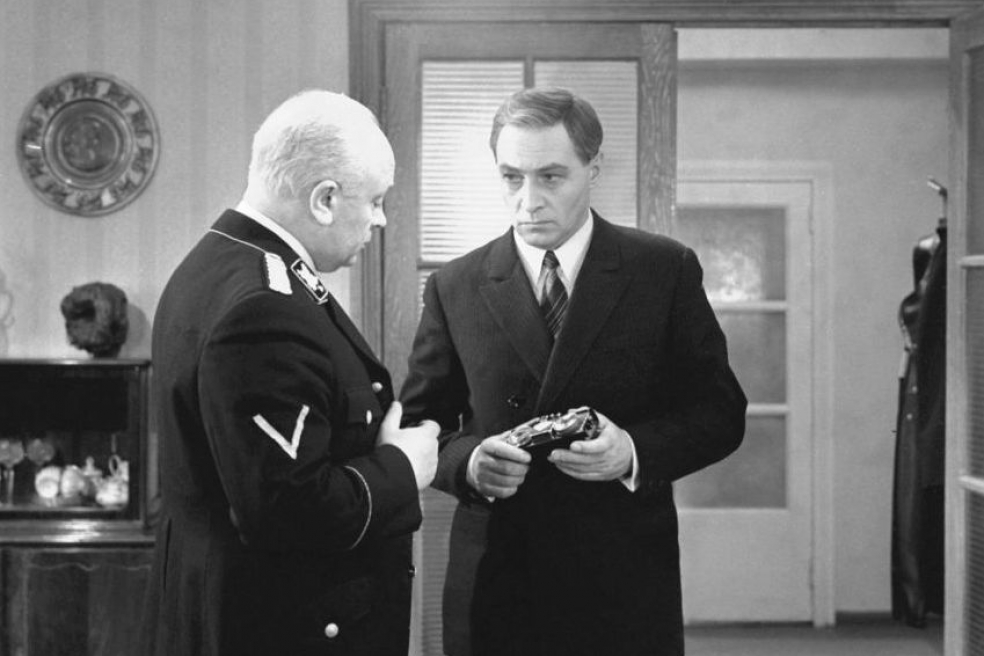
Interestingly, “Electron-52D”, which was filmed in the series as the legendary Stierlitz device, was the actual copy of the Tinico pocket recorder. For the 60s, when this gadget was created, its dimensions were considered extremely miniature. It can be said that Electron-52D was the first domestic serial compact tape recorder that was mass-produced and sold freely.
')
In this article, the history of the creation of “Electron-52D”, his appearance in the most famous Soviet spy series, as well as a few words about the bold experiment of an enthusiastic collector and radio amateur on evidence-based historical modeling.
Before the Electron-52D, there were no compact reel-to-reel tape recorders in the Soviet Union. Moreover, the tape recorders themselves were rare and cost a lot, in the mind of the Soviet person, money.
A prerequisite for the creation of a new device was the hypothetical need for such an apparatus among journalists and middle managers who could use the latter as a voice notebook.
From the end of the 40s, the secret services of the country of the Soviets successfully used captured wire aggregates, which in serial quantities were removed from the territory of the defeated Reich, and later the bourgeois Uher Report and Nagra SN. Similar devices or a class below got to the important journalists of major Soviet publications, but everyone else got out without voice recorders.

"Uher Report" - the "workhorse" of the KGB and international journalists
And then domestic officials from the radio-electronic industry noticed a small miracle of Japanese technology and decided that it would suit our people. The toy “Tinico”, developed in the mid-60s, would have been difficult to use as spy equipment, but it could have been made a dictaphone for ordinary Soviet citizens, which the USSR lacked so much.

Having received a distribution list from above and prototypes from the Land of the Rising Sun, the engineers of Poltava EMP began to create a domestic counterpart in 1966. Prototypes of the device appeared in 1967, and presumably since 1968, they went into series. After 2 years, in 1970, the technically successful device began to produce the Kazan plant of radio components.

'' Electron-52D "is a good example of how to copy devices. The Soviet engineers managed not only to play up a toy for the little Japanese, but also to make it better. This is a relatively rare case - for, as a rule, the opposite happened, the characteristics of Soviet copies were worse than the originals.

In the process of adapting and copying, Japanese samples have undergone several technical improvements. So, by increasing the voltage (from one and a half to three volts), the tape rewinding speed was increased and a circuit without transformers was implemented based on germanium transistors GT109A (2 pieces) and GT108A.
The resulting tape recorder, like its Japanese ancestor (which, let me remind you, was positioned at home as a toy) could successfully make a two-track tape recording. The speed of the tape during recording was variable from 3 to 9.5 cm / sec and was directly dependent on the winding of the tape on the reel.
This feature simplifies the design of the device, but completely deprives the user of the possibility of reliable recording and playback of music. In other words, the recorder was only suitable for speech.

The tape recorder was fed from a pair of nickel-cadmium batteries "TsNK-0.45" and a battery of the "Kron" type. '' Electron-52D ”was not equipped with a speaker and required for playback the connection of headphones or an amplifier with speakers.
In general, the characteristics of the device did not differ from the prototype:
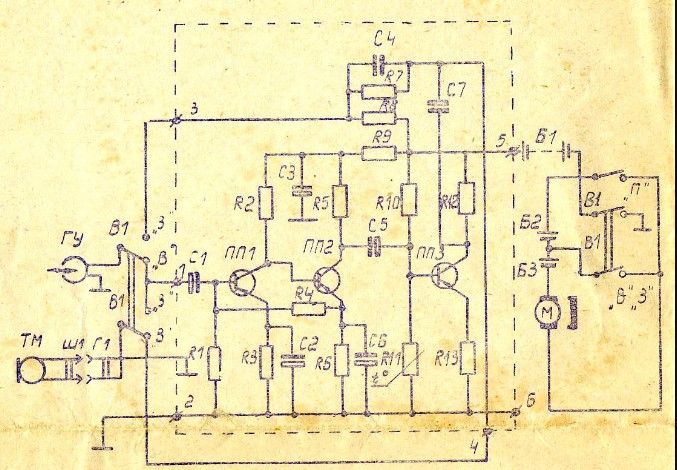
It is quite clear that it is extremely difficult to keep a hidden record with such characteristics. Moreover, the noisy operation of the engine and mechanics clearly produces a recording. These features have practically deprived the dictaphone of the future as a device for special services.
In the passport, the device is positioned as a voice note book. However, judging by what I know, 81 rubles in 1968 is quite a lot for a Soviet middle manager or engineer who could use such a gadget. Those who could afford it usually had secretaries with typewriters.
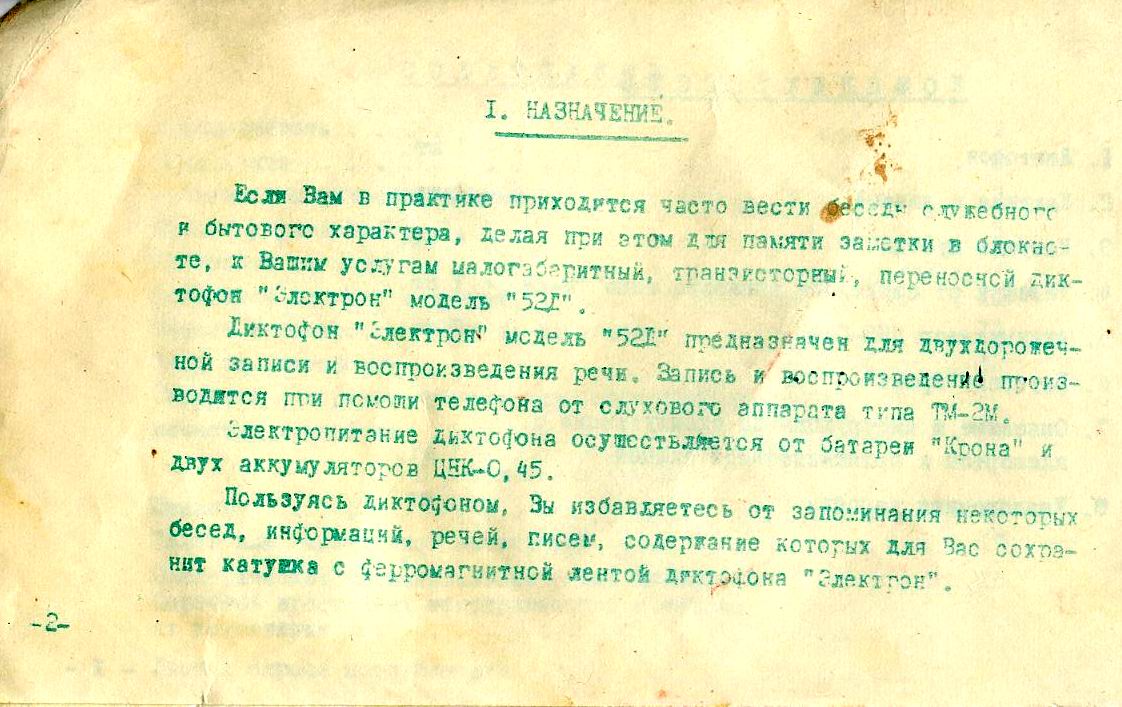
How much this almost useless device lay on the shelves of Soviet stores is unknown, but the fact is that its production turned off quite quickly. Intelligence agencies and the most class irreconcilable on the planet journalists continued to use the Swiss “Nagry” and piece products from the Central Research Institute of the KGB of the USSR. Others in need have not ceased to ask visiting friends to bring something more decent from the abroad, than an improved copy of a Japanese toy.
Due to the fact that the gadget did not become known and popular, and its series was relatively limited, when filming the legendary series about Stirlitz, they decided to pass it off as a German product from the WW2 era. The transformation of the gadget into the image of special equipment for GESTAPO and SD was done by sticking a SIEMENS logo onto the case of the device.
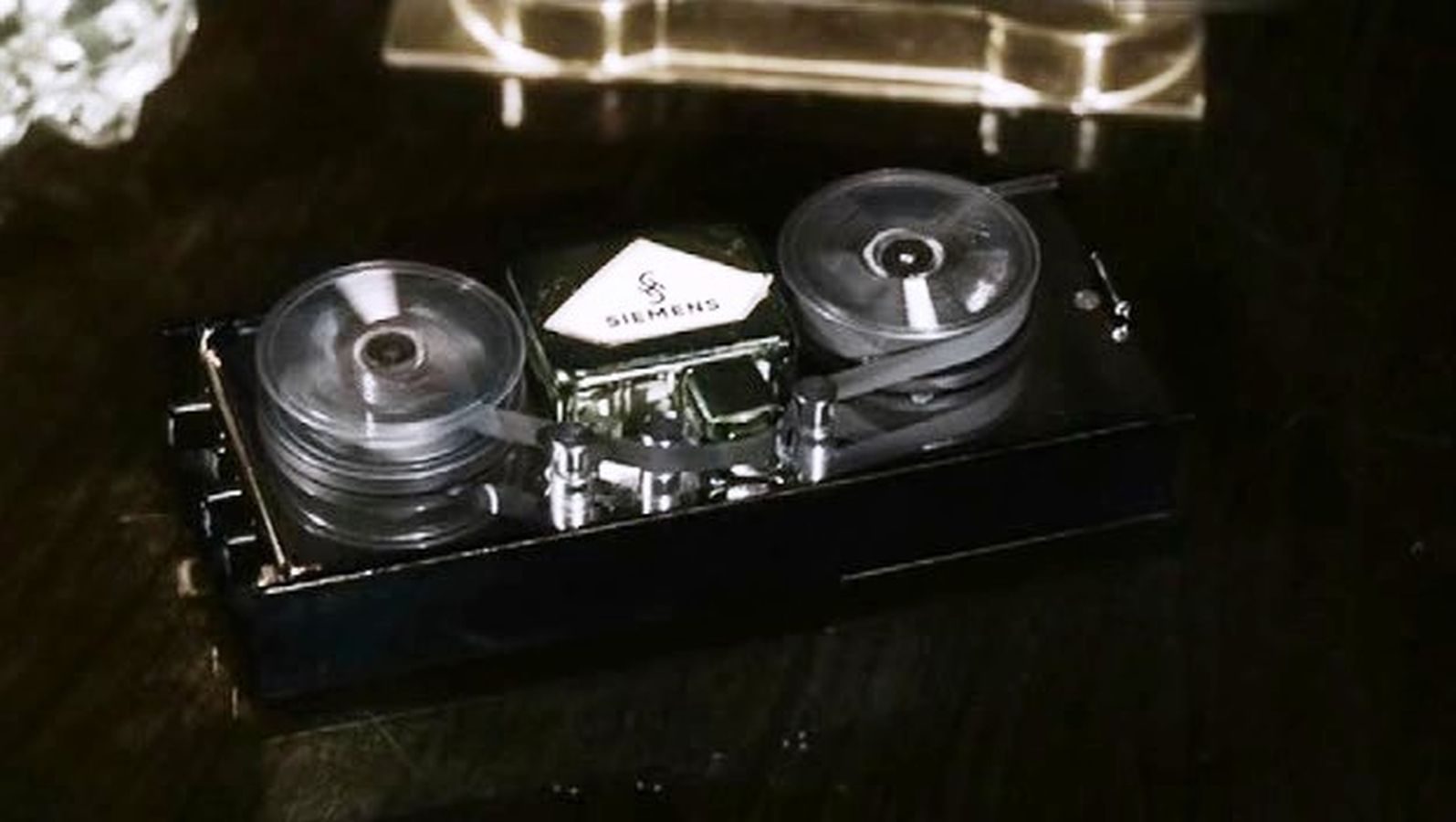
For many, even today this vintage voice recorder, first shown in a new capacity in 1973, personifies the technical power of the Third Reich. Dictaphone Stirlitz could much more than a Japanese toy in the Soviet version. In the film, the device is able to record long conversations, reproduce sound without additional devices, and work so quietly that even Agent Klaus easily secretly uses it in provocation with Pastor Schlag.
Many people superficially familiar with the history of audio, doubted the possibility of creating such a miniature recorder in those years. The main arguments of the doubters are based on the conviction that such a miniature voice recorder cannot be assembled on lamps, the Germans did not have sufficiently small batteries in the 40s, and also could not assemble a miniature electric motor.
At the same time, it is known that after some 6 years, Minifon tube wire recorders, which are comparable in size to Electron-52D, appeared in the open market.
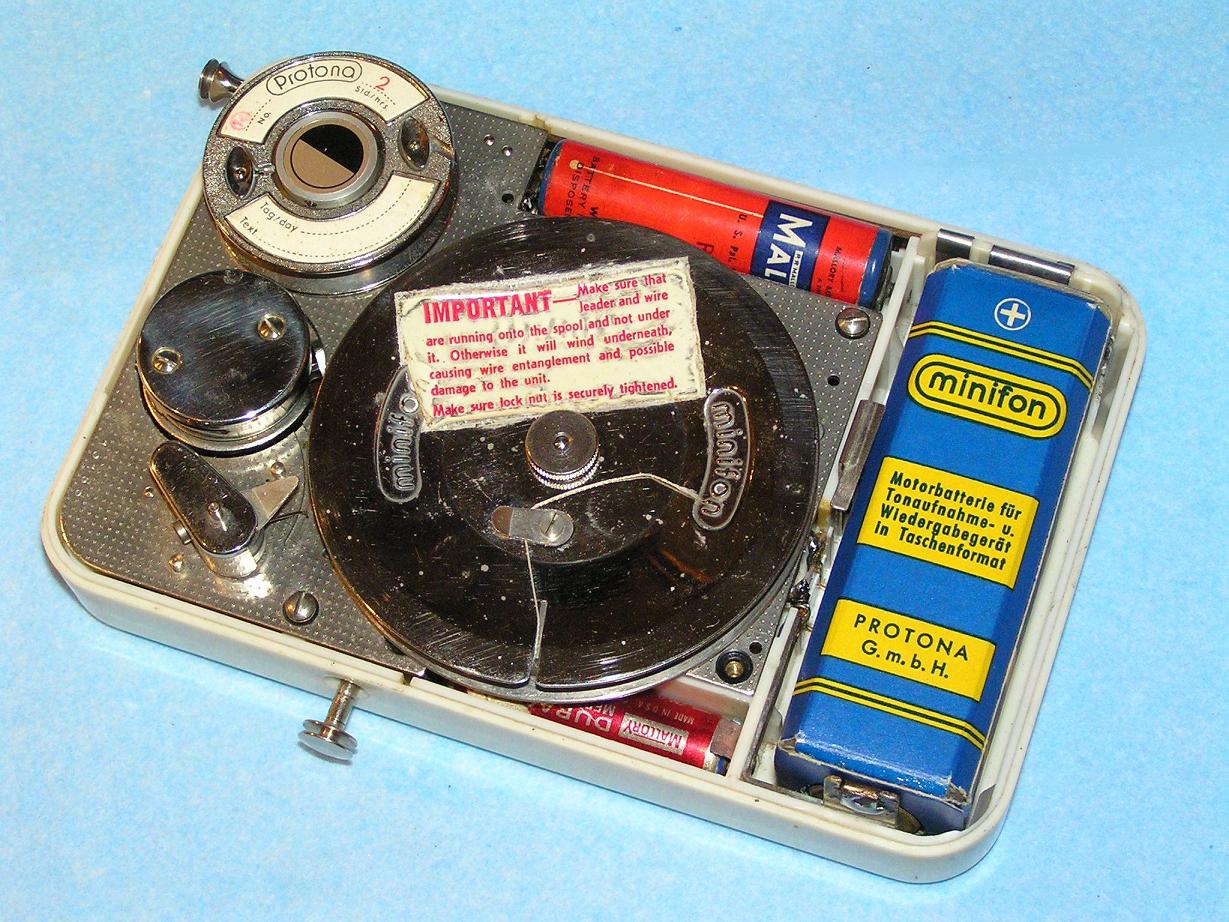
The point in question of the theoretical possibility to create a voice recorder of this size in the 1940s was put by a collector and author of the vintage-technics.ru project. He described in the article all the technologies that are needed to create such a device, gave a bunch of proofs (references to patents and the use of developments in practice) that such technologies existed.
Later, as proof, he created an adapted version of the Electron-52D using CK502AX, CK505AX sub-miniature lamps and other technologies that existed in the 1940s.
device diagram

appearance of a historical model

More detailed information on this titanic survey work, without exaggeration, can be obtained by reference .
Also there is a corresponding video .
I was skeptical about the possibility of creating such a compact voice recorder in the 40s, but after reading the article and the provided proofs, I had no doubt about this possibility.
“Electron-52D” was one of the examples of successful copying of Western devices. In the opinion of all those who held the prototype and the domestic device in their hands, the Soviet seems to be more perfect. At the same time, this experience shows that even successfully copied devices could be completely useless in the Soviet realities (like a toy, fabulously expensive, like a notebook, is irrational). Probably, if not for the “17 moments of spring” - we did not remember this device, but thanks to the film it became one of the most recognizable portable gadgets created in the USSR.
Photo content used:
vintage-technics.ru
rem-tv.net
www.menswork.ru
RuTLib.com
Special thanks to vintage-technics.ru for a lot of useful information and in general for the project.
Jeans
There is no special equipment in our catalog , but there are UMZCH, acoustic systems, DAC, headphones and other high fidelity audio equipment.

Interestingly, “Electron-52D”, which was filmed in the series as the legendary Stierlitz device, was the actual copy of the Tinico pocket recorder. For the 60s, when this gadget was created, its dimensions were considered extremely miniature. It can be said that Electron-52D was the first domestic serial compact tape recorder that was mass-produced and sold freely.
')
In this article, the history of the creation of “Electron-52D”, his appearance in the most famous Soviet spy series, as well as a few words about the bold experiment of an enthusiastic collector and radio amateur on evidence-based historical modeling.
Improved copy of Japanese toys
Before the Electron-52D, there were no compact reel-to-reel tape recorders in the Soviet Union. Moreover, the tape recorders themselves were rare and cost a lot, in the mind of the Soviet person, money.
A prerequisite for the creation of a new device was the hypothetical need for such an apparatus among journalists and middle managers who could use the latter as a voice notebook.
From the end of the 40s, the secret services of the country of the Soviets successfully used captured wire aggregates, which in serial quantities were removed from the territory of the defeated Reich, and later the bourgeois Uher Report and Nagra SN. Similar devices or a class below got to the important journalists of major Soviet publications, but everyone else got out without voice recorders.

"Uher Report" - the "workhorse" of the KGB and international journalists
And then domestic officials from the radio-electronic industry noticed a small miracle of Japanese technology and decided that it would suit our people. The toy “Tinico”, developed in the mid-60s, would have been difficult to use as spy equipment, but it could have been made a dictaphone for ordinary Soviet citizens, which the USSR lacked so much.

Having received a distribution list from above and prototypes from the Land of the Rising Sun, the engineers of Poltava EMP began to create a domestic counterpart in 1966. Prototypes of the device appeared in 1967, and presumably since 1968, they went into series. After 2 years, in 1970, the technically successful device began to produce the Kazan plant of radio components.

'' Electron-52D "is a good example of how to copy devices. The Soviet engineers managed not only to play up a toy for the little Japanese, but also to make it better. This is a relatively rare case - for, as a rule, the opposite happened, the characteristics of Soviet copies were worse than the originals.

In the process of adapting and copying, Japanese samples have undergone several technical improvements. So, by increasing the voltage (from one and a half to three volts), the tape rewinding speed was increased and a circuit without transformers was implemented based on germanium transistors GT109A (2 pieces) and GT108A.
What good Japanese children do not need a Soviet manager
The resulting tape recorder, like its Japanese ancestor (which, let me remind you, was positioned at home as a toy) could successfully make a two-track tape recording. The speed of the tape during recording was variable from 3 to 9.5 cm / sec and was directly dependent on the winding of the tape on the reel.
This feature simplifies the design of the device, but completely deprives the user of the possibility of reliable recording and playback of music. In other words, the recorder was only suitable for speech.

The tape recorder was fed from a pair of nickel-cadmium batteries "TsNK-0.45" and a battery of the "Kron" type. '' Electron-52D ”was not equipped with a speaker and required for playback the connection of headphones or an amplifier with speakers.
In general, the characteristics of the device did not differ from the prototype:
The working frequency range is 300 ... 3500 Hz, with an increase in the speed of 200 ... 7000 Hz;
Recording time when using a type 10 magnetic tape is from 10 to 30 minutes;
Nominal output power of the amplifier 20 mW;
Nonlinear distortion 15%;
detonation coefficient - 10%;
The relative level of interference -30 db;
The size of the voice recorder is 165x70x50 mm, its weight is 0.5 kg.

It is quite clear that it is extremely difficult to keep a hidden record with such characteristics. Moreover, the noisy operation of the engine and mechanics clearly produces a recording. These features have practically deprived the dictaphone of the future as a device for special services.
In the passport, the device is positioned as a voice note book. However, judging by what I know, 81 rubles in 1968 is quite a lot for a Soviet middle manager or engineer who could use such a gadget. Those who could afford it usually had secretaries with typewriters.

How much this almost useless device lay on the shelves of Soviet stores is unknown, but the fact is that its production turned off quite quickly. Intelligence agencies and the most class irreconcilable on the planet journalists continued to use the Swiss “Nagry” and piece products from the Central Research Institute of the KGB of the USSR. Others in need have not ceased to ask visiting friends to bring something more decent from the abroad, than an improved copy of a Japanese toy.
Do not think about seconds down
Due to the fact that the gadget did not become known and popular, and its series was relatively limited, when filming the legendary series about Stirlitz, they decided to pass it off as a German product from the WW2 era. The transformation of the gadget into the image of special equipment for GESTAPO and SD was done by sticking a SIEMENS logo onto the case of the device.

For many, even today this vintage voice recorder, first shown in a new capacity in 1973, personifies the technical power of the Third Reich. Dictaphone Stirlitz could much more than a Japanese toy in the Soviet version. In the film, the device is able to record long conversations, reproduce sound without additional devices, and work so quietly that even Agent Klaus easily secretly uses it in provocation with Pastor Schlag.
Many people superficially familiar with the history of audio, doubted the possibility of creating such a miniature recorder in those years. The main arguments of the doubters are based on the conviction that such a miniature voice recorder cannot be assembled on lamps, the Germans did not have sufficiently small batteries in the 40s, and also could not assemble a miniature electric motor.
At the same time, it is known that after some 6 years, Minifon tube wire recorders, which are comparable in size to Electron-52D, appeared in the open market.

The point in question of the theoretical possibility to create a voice recorder of this size in the 1940s was put by a collector and author of the vintage-technics.ru project. He described in the article all the technologies that are needed to create such a device, gave a bunch of proofs (references to patents and the use of developments in practice) that such technologies existed.
Later, as proof, he created an adapted version of the Electron-52D using CK502AX, CK505AX sub-miniature lamps and other technologies that existed in the 1940s.
device diagram

appearance of a historical model

More detailed information on this titanic survey work, without exaggeration, can be obtained by reference .
Also there is a corresponding video .
I was skeptical about the possibility of creating such a compact voice recorder in the 40s, but after reading the article and the provided proofs, I had no doubt about this possibility.
Total
“Electron-52D” was one of the examples of successful copying of Western devices. In the opinion of all those who held the prototype and the domestic device in their hands, the Soviet seems to be more perfect. At the same time, this experience shows that even successfully copied devices could be completely useless in the Soviet realities (like a toy, fabulously expensive, like a notebook, is irrational). Probably, if not for the “17 moments of spring” - we did not remember this device, but thanks to the film it became one of the most recognizable portable gadgets created in the USSR.
Photo content used:
vintage-technics.ru
rem-tv.net
www.menswork.ru
RuTLib.com
Special thanks to vintage-technics.ru for a lot of useful information and in general for the project.
Jeans
There is no special equipment in our catalog , but there are UMZCH, acoustic systems, DAC, headphones and other high fidelity audio equipment.
Source: https://habr.com/ru/post/417887/
All Articles